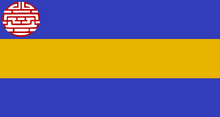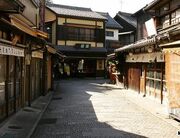
Flag of the State of Meiji
The State of Meiji, officially the Imperial State of Meiji (Aquitanian: Kaiserlichen Bundesstaat Meiji), (Meiji: 明治の連邦国家) is a Lusitanian Imperial State in the Lusitanian Empire.
The State of Meiji was aquired in the year 2966 after the Second Great War. It was formally annexed in the year 2972 by the Aquitanian Kingdom and declared a UKO State in the year 2973.
The State of Meiji has a strong cultural identity and traditional values that are centered around High Moral Values and research advancement. It has little difference from their past values except for the advancement introduction and corrected moral state.
The State borders the State of Cairstadt to the East; the Republic of Serbia to the West, The Cretan Sea to the North and the Northern Kingdom to the South.
The State of Meiji became the Imperial Federal State of Meiji when Aquitania withdrew from the UKO and Lusitania declared itself an Empire.
History[]
The History of the Meiji Region was recorded with great dedication, History depicts in its majority a Feudal Styled society that constantly had conflicts between each of the powerful Prefectures.
Ancient and Prefectural Times
The Meiji people came from the northwest in aproximate years of 20000BB-21000BB, by the year 2934BB they quickly developed into a great Empire, until the latter divided into "Prefectures" in the year 1053AB. The Prefectures shared the same culture, customs and language and so were "many out of one". The Feudal Lands were constantly feuding with each other for more power and territory. The most powerful prefecture was the Meiji Kazoku, in the year 2879 they were close to conquering the entire area known today as the Meiji Region, but they failed when the Calzadors invaded. The oppressive Calzador Rule was deemed to the Meiji as a threat to their Culture and this eventually caused them to unite as a people to resist the oppression and organize a revolt against the Calzador "pigs".
Second Great War
In the year 2964, the Meiji people led a revolution against the Calzadors, which were at the time waging war on the southern UKO Nation, so their revolt was filled with success. ONI learned of their revolution and contacted them and supported them throughout their campaign, until the Day of Death "Shi no hi" came. By the year 2966, ONI informed the Meiji leaders of the Operation Death Rain, and the Meiji people prepared refuges, supplied them with plenty of food and water rations and sealed themselves in them. After the Aquitanians had bombed the Calzador Core with bio bombs, after the Calzador War officials and barbaric people perished, the Meiji People emerged from their refuges. The Aquitanian Military assisted them in cleaning their lands, known as the process of Disinfection.
Protectorate Times

South Fenikkusu, Port Simplicity, Kingdom Tower (Tallest Tower in the City)
From 2968 to 2972, Meiji Region was a Protectorate of the Kingdom of Aquitania. The Protectorate Times brought industrialization, advances in medicine and technology and a couple million Aquitanians seeking new lives in the "Blooming State of the Central East". By the year 2971, the Protectorate was highly developed, a place where the Traditions and Cultural Customs were greatly encouraged, while also learning to cope with the rapid advances in technology. The great potential in the educating of Meiji Children immediately boosted the already rapid advances, "It was the perfect mix really" - Governor-General Halberg Dennitrov of Meiji.
During this time the Samurai Title and Status was abolished, several honour protocol rules like bowing before a Samurai or Noble Caravan or "Get Slashed" were abolished as well. Bowing to Noble Families and Old Samurai Families though is still considered an honourable gesture of courtesy. This "Courtesy" was also passed to bowing to passing Aquitanian High Noble Officials or Members of Government, both Aquitanian and Meiji.
The Protectorate times ended with the General ballot of 2972, where the people voted if they wanted independence or if they wanted to join the Lusitanian Federation of the UKO. The people voted to join the UKO and the Lusitanian Federation as a State with an incredible 92% in favor, the remaining percentage having abstained.
The State of Meiji / Present Day

Hoseki Skyline
Historians explain that the Meiji People accepted their annexation into the Aquitanian Lusitanian Federation of the UKO because of the freedom people were given compared to their preceding rulers. Today the Meiji State is a union that has great traditions and cultural heritage that survived millennia of treading until being officially restored after the Second Great War.

3010 Fenikkusu Port
After being declared a State, the capital was chosen in the central lands, the City of Hoseki. Chosen mainly because it had vasts spaces of land to expand and because of its cultural value. The City Finance District and several highways were constructed from 2967 to 2975. Now it prospers as a relatively middle sized alpha city. In the year 2976 though, the capital was shifted to the port City of Fenikkusu to the north. The shift was due to economic and strategic reasons, one of them being the fact that "His Majesty the King desires all capitals of State to be coastal and ports of call, as the Aquitanian Mastery of the Seas can be observed that way and that way only". - Sevrand Roivvas, Governor-General of the Lusitanian Federation.
2977 Wahaabi Invasion and Meiji Response
In December 20th, 2976, the guerrilla tribes crossed the North Haven-Meiji Border and took refuge in the Shansu Mountains of the north west. The invading tribes began harassing the nearby towns, murdering civilians, blockading the E-30 Highway, looting, burning vehicles and executing the motorists.
The Governor-General responded in less than two days with the bombardment of the Mountains with the OBUs, all life in the mountains was incinerated. After the bombardment, an envoy was sent to the tribe leader, warning them of similar action if they ever crossed the borders to the Aquitanian States again. The Tribes people, fearful, accepted and even offered tribute. The Diplomat Rejected the Tributes. The States of Aquitania are now secured of invasion and safe from the western rebels.
Culture[]

A Meiji Geisha
The Culture of the State is the Second Highest in the Lusitanian Federation and one of the Highest in Mainland UKO. Meiji People practice ancient customs and traditions with ease, Calzador "Corrupting" Customs were prohibited and rejected by the Aquitanian Officials in the year 2968. Calzador Customs which mixed in with the Meiji Culture in the past decades were considered stains and so were "removed from the system, we didn't need genocidal ideas in our fellow Meiji People" - ONI Official.

A Traditional Style Borough Street
The Cultural traits are considered one of the most beautiful in the UKO, where Samurai, Geishas, Tea Houses, Sakke Bars and Restaurants are preserved in their traditional style and done in the style it has been "done" for millennia. Samurai Families are known for preserving and conserving their Ancient Castles as their traditional homes, usually known for sharing them when foreign diplomats or Aquitanian Nobles and Officials who visit. Samurai were given the Status of "Noble" in an effort to conserve culture, though they have the same rights as everyone else. Noble Samurai dress in traditional outfits when the occasion requires it: A Diplomatic Visit that is scheduled to arrive at their castle, or when serving in the Government.

A Scene in the Finance District of Hoseki Showing Aquitanian Influence in Meiji
The beutiful Geishas which simply hipnotized Aquitanian Nationals were always encouraged and seen as a great Status in Meiji Society. Geishas, their serving and entertainment traditions that they practice (Shows, traditional ancient dances, both musical and art mastery) were preserved at their maximum. Calzadors unfortunately had thought of the term "Geishas" as some form of prosttitution and so tainted the practice. Traditional geishas though did not fall to that and prevailed. Prostitution was abolished and outlawed with the Aquitanian Occupation. The Geishas were restored to their greatness with the Occupation and Reconstruction.
Tea Houses, Sakke bars, Restaurants of the typical food, are all conserved and built in the ancient style, or old style. There are specific boroughs that only permit the construction of Meiji Styled buildings. Financial Districts and more modern buildings are constructed in their separate boroughs and districts (as stated).
Geography[]

A Meiji Temple contrasting with the Lusitanian Installations in the Background
Meiji is mostly boreal forest and highly mountainious on its far west. The Western Mountain Ranges and it's surroundings are referred to as the Meiji Highlands, which lodge ancient Meiji Temples, isolated historical towns and villages as well as having a slightly different Cultural Meaning to which the Highlanders Identify with. Plenty of ONI and Military bases abound in the Highlands, sometimes mixing with the mentioned earlier. Super Installations are also common in the Highlands but they are restricted and highly Confidential, their purpose is unknown, but telling by their size, the people believe they are super weapons or defence systems. Research Facilities are also suspected to make up these gigantic installations, where ONI and Military Transporters make the skies a major route that is never empty.
Government[]
The State of Meiji has three Branches. The Supreme Court of Justice, the Governor's Mansion and the Hall of Electorates.
Supreme Court of Justice - The Supreme Court of Justice is in charge of applying law and making sure it is followed.
Governor's Mansion - The Governor-General commands the State Guard and issues and declares the orders and wishes of the Hall of Electorates, the State budget is under his disposal.
Hall of Electorates - It is Unicameral and has the power to issue laws, raise and lower taxes at their disposal and sign treaties. It is the only elected body of government in the State and by far extension, the Kingdom of Aquitania.
The current Head of State is Governor-General Shaw Hiroto, appointed by His Majesty the King Alexander II of Aquitania.
Military[]
A notable Military Academy, the best in the Empire and in the Kingdom is the Meiji High Ground Military Academy, which is the most advanced in the Continent and which holds the second built Space Tether in the Planet. The Facility is managed by ONI.
The Academy is located deep in the Western Mountainious Forests of Meiji, close to the Border with the Developing Country "Republic of Serbia".
The Academy honours Tridius the Great of Aquitania, with a statue featuring him in a courtyard of this facility. The Academy is renowned for training Children of High Ranking Government Positions and of Nobility Bloodline.
Infrastructure[]
Infrastructure has been developed highly in accordance to Aquitanian Standards. Highways and Public Transportation Systems work closely together. Railway is left to the UKO Wide Bullet Train Project. Energy is harvested from the northern winds in the highlands of the north. The Plasma Hydro Plant near the Cretan Sea produces 54% of all the energy in the State of Meiji, the occasional low grade earth tremors in the northwest are important energy producers, as the Earthquake Heat and Movement Energy Absorber "Absorbs" (As the name implies), the energy released by these earthly movements and clashes between the lower layers. Healthcare is handled exactly as is in Aquitania. Maritime Routes in the Cretan Sea are very important as it provides Water Way Transport.
Transportation

A Meiji License Plate
Roads and Highways were designed in accordance to Aquitanian Standards, Wide and Clear "You have plenty of space, speed and street signs on our highways, based on my homeland. I have recently requested no speed limits in UKO Highways, but Kingdom and Province Delegations reject my proposals, they allowed no speed limits in the Lusitanian Federation though, which is great" - Dianne Korpatoff, Minister of Transportation.

